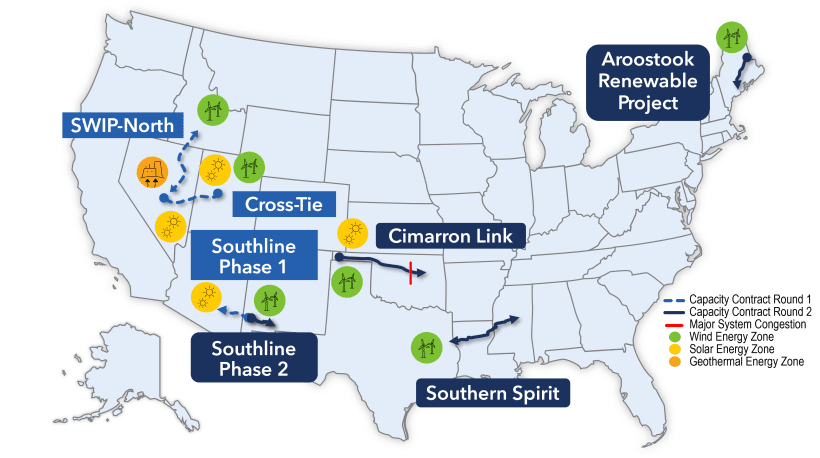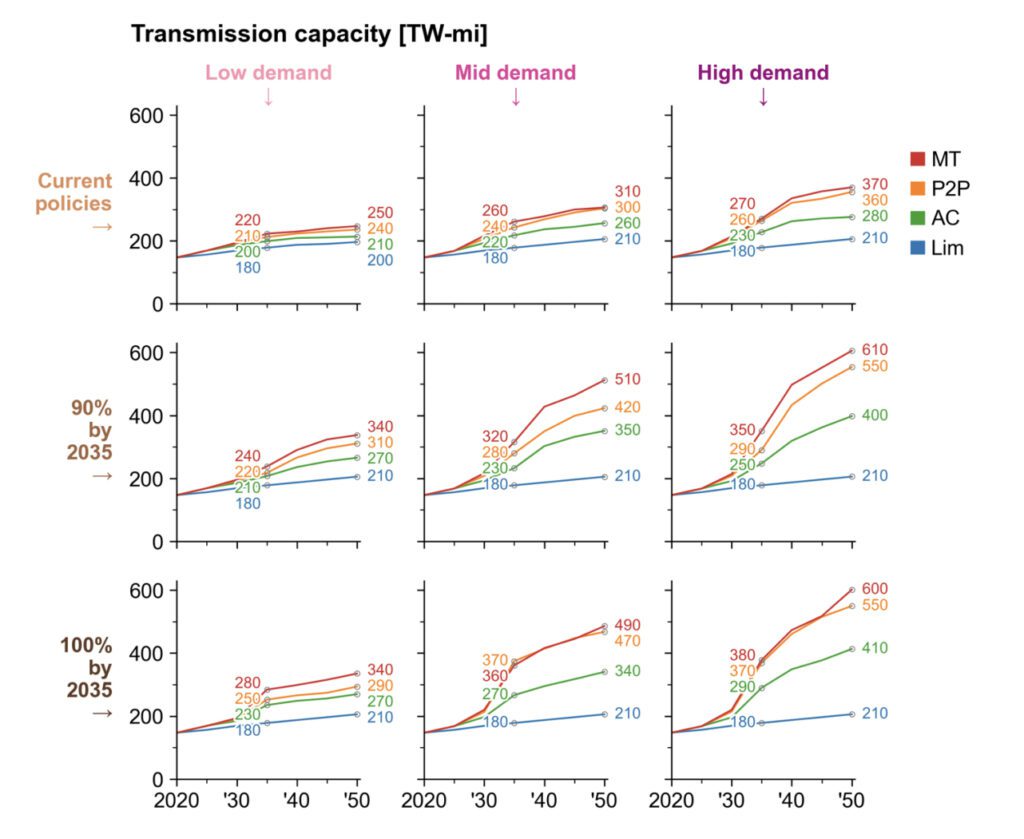$1.5B Federal Boost for Four Major Transmission Projects as DOE Unveils National Grid Study
The Department of Energy (DOE) has awarded capacity contracts of up to $1.5 billion to four major transmission lines under its Transmission Facilitation Program (TFP) to aid the transfer of 7.1 GW of new capacity throughout Louisiana, Maine, Mississippi, New Mexico, Oklahoma, and Texas.
The DOE’s Grid Deployment Office (GDO) on Oct. 3 also released its final 800-page National Transmission Planning Study (NTP), a crucial roadmap geared to help regional transmission organizations (RTOs), utilities, and other stakeholders plan and build out the transmission system. The study concludes that if the U.S. were to implement its “lowest-cost U.S. power system portfolios” that meet future demand growth and reliability requirements, it would need a transmission expansion of up to 2.1 to 2.6 times the size of the 2020 system by 2050 and an expansion of interregional transmission on a magnitude of 1.9 to 3.5.
The Four Transmission Projects Focus Heavily on Reliability, Resilience
The four new transmission projects mark the GDO’s second-round selections under the TFP, a $2.5 billion revolving fund enacted by the 2021 Infrastructure Investment and Jobs Act (IIJA). In its first round, unveiled in October 2023, the GDO awarded $1.3 billion in capacity contracts to three interregional projects: TransCanyon’s 1.5-GW Cross-Tie, spanning Utah and Nevada; National Grid’s Twin States Clean Energy Link, traversing New England and Québec; and Desert Southwest’s Southline Phase 1, which crosses Arizona into New Mexico.
Capacity contracts are an innovative financing approach that allows the DOE to help de-risk and accelerate the development of these major transmission projects that will unlock significant clean energy resources and grid resilience benefits across different regions. “DOE buys capacity on the lines, then sells it back. When new customers show up, we recover our funding, invest it back into new projects, and on and on it goes,” as Deputy Energy Secretary David Turk explained to reporters.

The four transmission projects unveiled on Thursday will now enter capacity contract negotiations with the DOE.
Southern Spirit Transmission (Texas, Louisiana, Mississippi—potential contract value: $360M. Pattern Energy’s Southern Spirit Transmission project will build a 320-mile, 525-kV high voltage direct current (HVDC) line connecting the Electric Reliability Council of Texas (ERCOT) grid with grids in the Southeastern U.S.—marking the first time ERCOT will be interconnected with other regional grids.
The line will provide 3 GW of bidirectional capacity between Rusk County, Texas, and Choctaw County, Mississippi. According to Pattern Energy, the project will use voltage source converter (VSC) HVDC technology to enhance grid reliability—helping to mitigate disruptions like those caused by Winter Storm Uri in Texas in 2021 while improving electric diversification.
“For a long time, we’ve stared at ERCOT and thought, how can we build more resilience into a system that looks more like an island than an interconnected grid, drawing on the resources in other parts of the country,” White House National Climate Adviser Ali Zaidi told reporters. “This build-out is really transformational in breaking down the barrier between ERCOT and the rest of the country.”
Cimarron Link (Oklahoma)—potential contract value: $306M. Invenergy’s Cimarron Link project is a 400-mile high-voltage direct-current (HVDC) transmission line connecting Texas County, Oklahoma, to Tulsa, Oklahoma. The line will transmit 1,900 MW of firm, point-to-point capacity, delivering consistent wind and solar energy from the Oklahoma panhandle to load centers in eastern Oklahoma and other parts of the Southwest Power Pool (SPP).
The project, which will have a 50-year lifespan, “will deploy the latest generation of HVDC technology, allowing greater control, more modular designs, and ease of operations, as well as the ability to quickly restore the network after a blackout,” the DOE noted. It will be essential for improving grid reliability in a region experiencing high demand growth, addressing the congestion identified in DOE’s 2023 National Transmission Needs Study (NEEDS), which is the latest iteration of its three-year transmission constraint assessment through 2040, it said.
“The strong support for this project at the local, state, and national level reflects the critical need this grid investment serves for Oklahoma, as it will enable the construction of energy infrastructure that the Panhandle has long sought,” said Shashank Sane, executive vice president and Head of Transmission at Invenergy.
Avangrid’s Aroostook Renewable Project (Maine)—potential contract value: $425M Avangrid plans to build a new substation in Haynesville, Maine, and a 111-mile, 345 kV transmission line with a capacity of 1,200 MW to connect the substation to the ISO-New England (ISO-NE) system at Pittsfield, Maine. Additionally, a new 38.5-mile, 345 kV overhead line will connect Pittsfield to the Coopers Mills substation in Windsor, Maine. The project is considered crucial in unlocking Maine’s renewable energy potential, particularly by overcoming existing transmission constraints that have hampered the development of wind and solar resources in the region.
Southline Transmission Phase 2 (New Mexico)—potential contract value: $352M. Building off Phase 1, which won an award in the first TFP round, the Southline Phase 2 project will construct a 108-mile, 345 kV transmission line to deliver 1,000 MW of bidirectional capacity between Hidalgo County and Las Cruces, New Mexico.
“Southline Phase 2 will add much-needed transmission capacity to support electricity delivery across the desert southwest region, which is grappling with extensive load growth and an increase in resource demand driven by residential, commercial, and industrial activity,” the DOE said.
Part of a Broader Grid Modernization Strategy
Biden administration officials told reporters the second round of TFP selections signals tremendous progress to cement U.S. grid modernization. “Like many things about the clean energy transition, building new transmission is extremely challenging and it’s also extremely urgent,” Turk said. “This program is a prime example of how the Biden-Harris administration is innovating to get it done, and it is working.”
But the officials on Wednesday underscored that the selections are only one part of a broader, multi-pronged strategy to kickstart a transmission expansion. Despite repeated calls from the power industry over decades for a holistic modernization of the bulk power system to enable more efficient and reliable power generation and delivery, action has often been piecemeal and catered to changing market and policy forces.
As POWER has reported, recent developments over the past year have injected fresh optimism for meaningful progress toward the much-needed transmission expansion. The federal government recently launched Federal-State Modern Grid Deployment Initiative, which fosters collaboration between the federal government and 21 states to address grid challenges like rising demand and aging infrastructure. The DOE also recently issued the 2023 National Transmission Needs Study, which emphasized the need for substantial transmission expansion, with 54,500 GW-miles of new transmission required by 2035 to meet future energy demands and support the clean energy transition.
In May, it moved to identify 10 preliminary “National Interest Electric Transmission Corridors” (NIETCs)—areas experiencing or facing capacity constraints. Additionally, FERC has issued Order 2023, which introduced reforms to streamline interconnection processes. FERC’s Order No. 1920, issued in May, more solidly addressed regional transmission policy and the need for long-term transmission planning.
National Transmission Study Designed to Fill Gap for ‘Holistic’ Assessment
The final National Transmission Planning Study unveiled on Thursday aims to furnish industry with critical data, analytical tools, and insights to guide the planning and development of the transmission system. As Turk explained, the multi-year study examines a variety of future scenarios and energy mixes, examining benefits such as “grid reliability, especially in response to extreme weather events.” But it also considers “consumer savings—the study projects up to $490 billion in system cost savings by 2050—and integrating new and cleaner generation onto the grid,” he said.
The study, developed through a collaboration between GDO, the National Renewable Energy Laboratory (NREL), and the Pacific Northwest National Laboratory (PNNL), is designed to fill a glaring gap in transmission planning identified by the 2023 Needs study. It calls for a more “holistic” examination of transmission that takes into account the dynamic nature of extreme events, generation and demand mismatches, and regulatory and institutional barriers. At its core, the National Transmission Planning Study’s findings present a tangible, informed argument for why more transmissions should be built.
The study stands apart from previous analyses because it inherently includes interregional transmission in its national perspective. “Interregional transmission solutions are not often included in bottom-up planning actions taken by existing transmission planning organizations,” it notes. “However, without a national or multiregional perspective, stakeholders may miss viable transmission expansion opportunities that can lead to significant potential systemwide savings.”
In addition, it considered business-as-usual alongside “ambitious” scenarios that assume more stringent decarbonization policies for many regions as well as emerging technologies, including for transmission, generation, and storage. GDO, NREL, and PNNL note they arrived at their findings through an exhaustive study of 96 modeled future grid scenarios utilizing a multimodel analytic framework.

Key Findings from the National Transmission Planning Study
Here is a high-level look at the study’s key findings:
Transmission Expansion and Cost Savings. Under current policies, the U.S. transmission system will need to expand 2.1 to 2.6 times its 2020 size by 2050, with interregional transmission growing 1.9 to 3.5 times. Coordinating interregional transmission could save the U.S. electricity system “hundreds of billions” of dollars while reducing carbon dioxide emissions by 10 to 11 billion metric tons through 2050.
Net Benefits of Large-Scale Transmission. If the U.S. aims for a 90% reduction in greenhouse gas emissions by 2035 and 100% by 2050, accelerating transmission expansion can yield between $270 and $490 billion in net savings. Every dollar spent on transmission results in $1.60 to $1.80 in reduced system costs, covering fuel, generation, and storage needs, the study says. “The benefits of transmission expansion to system costs scale with the level of electricity demand and rate of decarbonization,” it stresses.
Broad Transmission Expansion. To achieve the largest benefits, transmission must expand 2.4 to 3.5 times by 2050. High-voltage direct current (HVDC) technologies, including advanced multiterminal converters, are slated to play a critical role in long-distance transmission, particularly across central U.S. regions. But the largest benefits of transmission are realized when interregional transmission is the most substantial, “including building across the interconnection seams.” On the flip side, if transmission remains constrained, “higher cost portfolios with more nuclear generation, hydrogen, and carbon capture capacity” will be required, especially when carbon emissions are limited.
Grid Reliability and Resource Adequacy. Coordinated transmission utilization allows all scenarios—even those with 90% of energy from renewable sources—to meet resource adequacy standards. “When transmission regions coordinate to achieve resource adequacy, system costs through 2050 are lowered by $170 billion to $380 billion.” In addition: “High-resolution grid simulations demonstrate hourly demand and supply can be balanced in power systems with very high shares of renewable energy,” the study notes. “In scenarios with larger transmission expansion, imports and exports between regions play a substantial role in helping grid operators balance supply and demand in all hours.”
High Opportunity Transmission (HOT) Interfaces. The study identifies potential transmission expansion opportunities between regions, known as HOT interfaces, which could be prioritized for further planning and development. These projects promise significant system flexibility and cost reductions, it suggests.
Need for Enhanced Coordination. No matter what the future brings, in terms of policy, market, or technology conditions, effective grid planning will require institutional coordination, advanced modeling, and accessible data to handle future uncertainties like extreme events and technological advancements. The study underscores the importance of collaborative approaches to realize the benefits of large-scale transmission expansion.
—Sonal Patel is a POWER senior editor (@sonalcpatel, @POWERmagazine).
Updated (Oct. 4): Adds comments from Pattern Energy explaining how ERCOT’s independence is preserved under the federal approval for the Southern Spirit Transmission project.